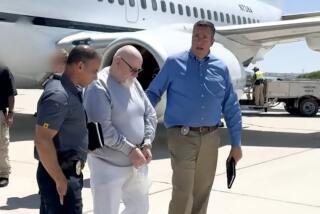Attacks That Bombed Occurred 49 Years Ago : World War II: Explosives borne by paper balloons drifted all the way from Japan to Ventura County, but caused no damage.
- Share via
It wasn’t exactly a day of infamy in Ventura County--hardly anyone knew what happened.
But 49 years ago today--Jan. 15, 1945--the winds of war brought the first of up to three spectacularly unsuccessful and almost unnoticed Japanese assaults on Ventura County.
The attacks were carried out not by enemy submarines, or even by long-distance bombers. These bombs came by balloon-- paper balloons --sent all the way from Japan.
Except for putting up some defensive gun emplacements, Ventura County saw little action for most of World War II. But in the early part of 1945, Fugo balloon bomb attacks were recorded in the county.
The first created a crater in the dry bed of the Santa Clara River near Saticoy on Jan. 15. Two days later, an entire balloon was found in Moorpark, still containing untriggered incendiary bombs but missing the 33-pound anti-personnel bomb carried by the balloons. Remnants of a third balloon bomb were found Feb. 21 in Oxnard.
The balloon found in Moorpark may have been the same one that dropped the explosive on the Santa Clara riverbed, according to Richard Senate, a Thousand Oaks-based historian who specializes in Ventura County’s past.
“It’s probably the only time anyone could actually say that the war came to Ventura County,” Senate said. “These balloons were very ingeniously designed devices on the drawing board. Luckily for us, they didn’t perform well in real life.”
The Japanese attack on the county wasn’t revealed at the time, Senate and others said. Local news media agreed with government officials to squelch reporting of the incident to prevent the Japanese from knowing whether their unassuming weapons actually made it to American shores.
“It wasn’t until 1947 did we see any kind of news reports about the balloons,” Senate said. “By then, people were getting on with their lives and didn’t really seem to care too much about the incident.”
No other landings in Southern California were recorded, although remnants of a balloon were found floating about 60 miles west of San Pedro.
The balloons, about 70 feet high and 30 feet in diameter, were first launched from Japan in November, 1944. The idea, according to Tom Crouch, chairman of the Smithsonian Institution’s Department of Aeronautics in Washington, was to start hundreds of forest fires in California and throughout the Pacific Northwest.
Designed to ride the swift west-to-east high-altitude jet stream, the estimated 10,000 balloons launched by the Japanese army malfunctioned by the hundreds. Crouch said it’s possible that only one in 10 of the devices made it across the Pacific, to places as far-flung as Alaska and Mexico. An estimated 355 of the airborne bombs were credited with reaching U.S. territory, some getting as far inland as Michigan and Texas.
“They wanted to set the Northwest on fire,” Crouch said. “It was a desperation move. They wanted to strike back at us for our aerial bombing raids.”
Both Crouch and Bert Webber, an Oregon-based historian who has written four books on the subject, agree that the balloon launches were one of the last gasps of the weakened Japanese war machine.
Webber said that despite their designers’ intention of wreaking wide devastation, the bombs are known to have caused only six fatalities among U.S. civilians. On May 5, 1945, a woman and five children on a church picnic in Oregon became the only known victims when they approached a downed balloon and its 33-pound bomb exploded unexpectedly.
The balloons themselves were made of paper and glued together with potato paste. The air envelope was filled with hydrogen and an elaborate system of ballast weights linked to a barometer managed the device in flight.
When the balloon would lose altitude, Webber said, a small explosive device--about the size of a shotgun shell--would fire and a ballast weight would be released, allowing the balloon to resume its normal operating altitude--about 38,000 feet. A typical crossing took two to three days, he said.
Webber said the balloon bomb attacks would have been stepped up by the Japanese had the American forces not started even more intensive aerial bombing over Japan with B-29 Superfortress bombers.
“There’s evidence indicating that they were ready to launch even larger balloons with larger bomb loads,” Webber said. “What stopped them was our B-29 raids over Japan. It literally crushed their ability to make the things.”
For Senate, however, the balloon bombs--despite their significant failure rate--showed the resourcefulness of the Japanese military.
“They used Japanese schoolgirls to construct these things using non-strategic materials such as paper and potato paste,” Senate said. “For very little money they were essentially making unguided missiles.”
More to Read
Sign up for Essential California
The most important California stories and recommendations in your inbox every morning.
You may occasionally receive promotional content from the Los Angeles Times.








